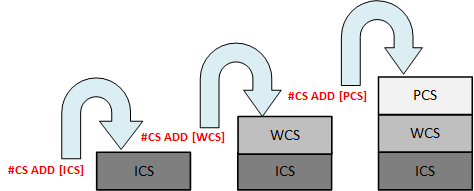Defining and linking coordinate systems (#CS ADD)
Syntax of Defining and linking CS: |
#CS ADD [<name>] [ <v1>,<v2>,<v3>,<φ1>,<φ2>,<φ3> ] |
<name> | Name of the CS with maximum of 8 characters This name can address the CS using all other appropriate NC commands. The names ACS, IMCS and MCS have a fixed present meaning and may not be assigned freely. (See #TRANSFORM command). A maximum of 5 CS definitions can be defined and linked. |
<vi> | 3 components of the translatory offset vector in [mm, inch]. (They refer to the main axes in the sequence contained in G17). |
<φi> | 3 angles of rotation in [°]. |
Linking to a CS stack is formed by programming a #CS ADD sequence. The new CS programmed last is always the top CS in the stack. The individual CS's are linked in the order of programming from bottom to top depending on the stack structure. The translatory and rotary shifts refer to the origin of the previous CS. The same rules apply to the rotation sequence and rotation mode as for standard CS programming.
The CS stack can be used at interpolator level to display the currently transformed coordinates.

Programing Example

Link 3 CS’s with #CS ADD to form a stack
:
N10 #CS ADD [ICS] [10,10,0,0,0,45]
N20 #CS ADD [WCS] [15,20,0,0,0,0]
N30 #CS ADD [PCS] [10,15,0,0,0,5]
:
Nxx M30